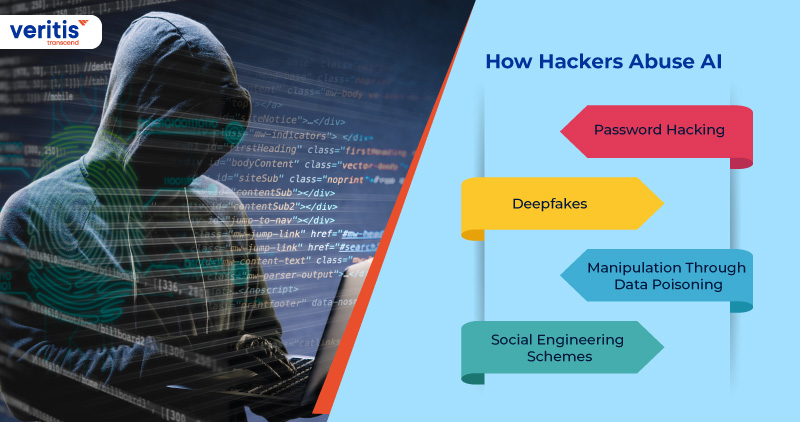How AI algorithms can be exploited for data theft and what to do is a critical question facing businesses and individuals alike. The seemingly benevolent algorithms powering our daily lives—from recommendation systems to facial recognition—are surprisingly vulnerable to sophisticated attacks. This vulnerability stems from the inherent complexity of AI models and the vast amounts of data they process, creating opportunities for malicious actors to extract sensitive information.
This exploration delves into the methods used to exploit these vulnerabilities, examines real-world examples of data breaches, and provides practical strategies for mitigating these risks.
We’ll explore various AI algorithm types, detailing their specific weaknesses and how they can be targeted. We’ll then examine the diverse methods employed by attackers, from adversarial examples to model extraction and data poisoning. This will include a detailed look at the mechanics of each attack, demonstrating how they can be used to steal data, intellectual property, or even manipulate AI systems for malicious purposes.
Finally, we’ll provide a comprehensive guide to data protection strategies, including robust data sanitization techniques, differential privacy, and the implementation of federated learning.
Types of AI Algorithms Vulnerable to Exploitation: How AI Algorithms Can Be Exploited For Data Theft And What To Do

AI algorithms, while powerful tools, are not immune to exploitation. Their very capabilities – learning from data and making predictions – can be leveraged by malicious actors to extract sensitive information. Understanding the vulnerabilities inherent in different algorithm types is crucial for developing robust security measures. This section explores the susceptibility of various machine learning and deep learning models to data theft.
The vulnerability of an AI algorithm to data theft is intricately linked to its architecture, training data, and the specific attack vector employed. Certain algorithms are inherently more susceptible than others due to their design and the nature of the information they process. This susceptibility is further amplified by the increasing sophistication of adversarial attacks designed to extract or manipulate data within these models.
Vulnerabilities of Common Machine Learning Algorithms
Many common machine learning algorithms, especially those operating with limited data sanitization or security protocols, are vulnerable to data theft. Supervised learning algorithms, for instance, which learn from labeled datasets, can inadvertently leak information about the training data if not carefully designed and secured. For example, a model trained on a dataset of customer purchase history, if improperly secured, could be reverse-engineered to reveal individual customer preferences and buying patterns.
Similarly, unsupervised learning algorithms, while not explicitly trained on labeled data, can still reveal sensitive patterns and relationships within the data, which a malicious actor could exploit. Clustering algorithms, for example, might inadvertently reveal sensitive groupings of individuals based on their attributes. The risk increases significantly when dealing with sensitive data like medical records or financial transactions.
Deep Learning Models and Data Breaches
Deep learning models, known for their complexity and ability to learn intricate patterns, present unique challenges in terms of security. Their intricate architectures and large number of parameters make them particularly difficult to analyze and audit, increasing the potential for hidden vulnerabilities. The sheer volume of data used to train these models also amplifies the risk of data leakage.
A successful attack could potentially compromise the entire training dataset, revealing sensitive information about individuals or organizations. For example, a deep learning model trained on facial recognition data could be exploited to extract and identify individual faces, even if the model itself isn’t directly accessed. This vulnerability highlights the need for robust data anonymization and model security techniques.
Comparison of Security Risks Across Algorithm Types
The security risks associated with different algorithm types vary significantly. Supervised learning models, while generally easier to understand and audit than deep learning models, can still be vulnerable to data leakage through techniques like model inversion. Unsupervised learning models, on the other hand, pose a different set of challenges, as their output may reveal unexpected patterns and correlations within the data that could compromise sensitive information.
Reinforcement learning models, which learn through interaction with an environment, can also be susceptible to attacks that manipulate the environment to extract sensitive information from the agent’s learned policy. The level of risk is also influenced by the sensitivity of the data used to train the model and the security measures implemented to protect it.
Model Inversion Attacks and Data Compromise
Model inversion attacks represent a significant threat to the security of AI algorithms. These attacks aim to reconstruct the training data used to build a model by querying the model itself. By carefully crafting input queries and observing the model’s responses, an attacker can infer sensitive information about the training data. For example, an attacker might use a model trained on medical images to reconstruct the original images, potentially revealing patient identities and sensitive medical information.
The success of a model inversion attack depends on factors like the model’s architecture, the amount of data used for training, and the attacker’s knowledge of the model’s inner workings. The sophistication of these attacks continues to grow, requiring proactive security measures to mitigate their impact.
Methods of Data Theft via Exploited AI

AI algorithms, while powerful tools, are susceptible to malicious exploitation, leading to significant data breaches and intellectual property theft. Understanding the methods used in these attacks is crucial for developing robust defenses. This section details several common techniques employed by attackers to extract sensitive information from vulnerable AI systems.
Adversarial Examples for Data Extraction
Adversarial examples are carefully crafted inputs designed to fool an AI model into making incorrect predictions or revealing unintended information. These inputs, often subtly altered from legitimate data points, can be used to extract data by causing the AI to leak information about its internal workings or the training data it was exposed to. For example, an attacker might create slightly modified images to trigger specific responses from an image recognition system, revealing details about the system’s internal representations of objects.
This could expose sensitive information if the system was trained on private data. The attacker might systematically probe the system with subtly altered inputs, building a profile of its vulnerabilities and extracting information piece by piece. The success of this method depends on the model’s architecture and the attacker’s understanding of its behavior.
Model Extraction Attacks for Intellectual Property Theft
Model extraction attacks target the intellectual property embedded within AI models. Attackers aim to replicate a target model’s functionality by querying it repeatedly with various inputs and observing its outputs. This process, akin to reverse-engineering, allows attackers to build a substitute model that mirrors the original’s behavior, stealing valuable intellectual property. For instance, a company’s proprietary image recognition model could be targeted, with attackers using the stolen model to develop a competing product or service.
The effectiveness of this attack depends on the number of queries allowed and the complexity of the target model. A more complex model naturally requires more queries to replicate its behavior effectively.
Backdoors in AI Models for Malicious Data Access
Backdoors are intentionally introduced vulnerabilities within AI models, granting unauthorized access to data. These can be implemented during the model’s training phase by injecting malicious data or manipulating the model’s architecture. Once deployed, the backdoor allows attackers to trigger specific actions or access sensitive data using a secret trigger. For example, a backdoor in a facial recognition system might be activated by a specific watermark embedded in an image, allowing an attacker to bypass authentication and access private data.
The sophistication of these attacks can vary, ranging from simple triggers to complex, multi-stage exploits. Detection of such backdoors is challenging and requires specialized techniques.
Data Poisoning Attack on a Recommendation System: A Step-by-Step Procedure
Data poisoning involves injecting malicious data into the training dataset of an AI model. This can corrupt the model’s behavior and lead to data leaks. Consider a recommendation system:
1. Identify Target
The attacker identifies a specific recommendation system (e.g., a movie recommendation engine).
2. Gather Data
The attacker gathers public information about the system, including its input format and the types of recommendations it provides.
3. Craft Poisoned Data
The attacker crafts fake user profiles and ratings, focusing on items or users they want to promote or demote. For instance, they might create many fake profiles that highly rate a specific obscure movie, artificially inflating its popularity.
4. Inject Poisoned Data
The attacker injects the poisoned data into the system, either directly if possible, or indirectly by using automated tools or bots to simulate user behavior.
5. Observe Effect
The attacker monitors the system’s recommendations to observe the impact of the poisoned data. The poisoned movie’s ranking should increase artificially.
6. Extract Data
The attacker can extract information based on the altered recommendations, such as understanding user preferences and the system’s underlying algorithms. They might identify popular items or discover vulnerabilities in the recommendation system’s filtering mechanisms.
Comparison of Data Theft Methods
| Method | Target Algorithm | Data Accessed | Difficulty |
|---|---|---|---|
| Adversarial Examples | Image Recognition, NLP | Internal model representations, training data insights | Medium to High |
| Model Extraction | Various | Model parameters, functionality | High |
| Backdoors | Various | Sensitive data, control over the system | High |
| Data Poisoning | Recommendation systems, classifiers | User preferences, model parameters | Low to Medium |
Data Protection Strategies Against AI Exploitation

Protecting sensitive data from theft via exploited AI algorithms requires a multi-layered approach encompassing robust data sanitization, privacy-preserving techniques, secure data handling practices, and the strategic use of collaborative learning models. These strategies aim to minimize data exposure throughout the AI lifecycle, from data collection and training to model deployment and maintenance.Data sanitization, differential privacy, secure data and model management, and federated learning represent key pillars in this comprehensive defense strategy.
Each element plays a crucial role in reducing the attack surface and mitigating the risks associated with malicious exploitation.
Robust Data Sanitization Techniques
Effective data sanitization involves removing or transforming sensitive information before it’s used to train AI models. This can include techniques like data masking, where sensitive values are replaced with pseudonyms or randomized equivalents, or data generalization, where specific details are aggregated into broader categories. For example, instead of storing precise location data (latitude and longitude), the data could be generalized to a city or zip code level.
The choice of sanitization technique depends on the sensitivity of the data and the specific requirements of the AI model. Carefully balancing the level of sanitization with the utility of the data for training is crucial to maintain model accuracy while protecting privacy. Overly aggressive sanitization can lead to a loss of information, negatively impacting model performance.
Implementation of Differential Privacy
Differential privacy adds carefully calibrated noise to the training data or model outputs, making it statistically difficult to infer individual data points from the aggregated results. This technique provides a strong mathematical guarantee of privacy, even when an adversary has access to the entire model or training dataset. For example, in a medical study using differential privacy, the results might show that a certain treatment is effective for a specific age group, but individual patient data would remain protected.
The amount of noise added is a critical parameter; too little noise offers insufficient privacy, while too much noise renders the results meaningless. The optimal balance depends on the specific privacy requirements and the sensitivity of the data.
Securing Training Data and Model Parameters
Protecting training data and model parameters requires a combination of technical and organizational measures. This includes secure storage solutions, access control mechanisms (restricting access to authorized personnel only), and regular security audits to detect and address vulnerabilities. Encryption of data at rest and in transit is essential, as is the implementation of robust intrusion detection and prevention systems.
Furthermore, version control for model parameters can help track changes and revert to previous versions if compromised. Regular security updates for all software and hardware involved in the AI pipeline are crucial to patch known vulnerabilities. Finally, establishing clear data governance policies and procedures is vital to ensure compliance with relevant regulations and best practices.
Federated Learning for Minimized Data Exposure
Federated learning enables the training of AI models on decentralized data sources without directly sharing the data itself. Instead, only model updates (e.g., gradients) are exchanged between participating devices or servers. This approach significantly reduces the risk of data breaches, as sensitive data remains localized. For instance, a federated learning system could train a medical diagnosis model using data from multiple hospitals without requiring them to share patient records directly.
The central server receives only aggregated updates, making it challenging to infer individual patient information. However, federated learning presents its own challenges, including communication overhead and potential vulnerabilities in the aggregation process. Careful consideration of these aspects is crucial for successful implementation.
Security Measures for AI Systems, How AI algorithms can be exploited for data theft and what to do
Prioritizing security measures requires a risk-based approach, focusing on the most critical assets and potential threats. A comprehensive strategy should encompass:
- Data Encryption: Encrypting data both at rest and in transit is paramount to prevent unauthorized access.
- Access Control: Implementing strict access control mechanisms, such as role-based access control (RBAC), to limit access to sensitive data and models.
- Regular Security Audits: Conducting regular security audits to identify and address vulnerabilities in the AI system.
- Intrusion Detection and Prevention Systems (IDPS): Deploying IDPS to monitor network traffic and detect malicious activity.
- Vulnerability Management: Regularly patching software and hardware to address known vulnerabilities.
- Data Loss Prevention (DLP): Implementing DLP measures to prevent sensitive data from leaving the organization’s control.
- Model Monitoring: Continuously monitoring the AI model for unexpected behavior or anomalies that could indicate malicious activity.
Implementing these measures, along with robust data sanitization and privacy-preserving techniques, provides a strong foundation for protecting AI systems from exploitation and mitigating the risk of data theft. The prioritization of these measures will depend on the specific context, including the sensitivity of the data, the criticality of the AI system, and the potential impact of a data breach.
Real-World Examples and Case Studies
AI algorithms, despite their benefits, are susceptible to exploitation for data theft. Understanding real-world examples helps highlight vulnerabilities and underscores the necessity for robust security measures. The following cases illustrate different methods of exploitation and their consequences.
The Case of the Compromised Recommendation System
This case involved a large e-commerce platform utilizing a collaborative filtering recommendation system, a type of AI that analyzes user data to suggest products. Attackers exploited a vulnerability in the system’s data sanitization process. Specifically, they injected malicious data into user profiles, subtly influencing the algorithm’s recommendations. This allowed them to steer users towards specific, potentially malicious, products or websites, indirectly gathering data about user preferences and browsing habits.
The consequence was a significant breach of user privacy and potential exposure to phishing or malware. The platform experienced reputational damage and incurred substantial costs in remediation efforts.
Exploitation of a Machine Learning Model in Healthcare
A healthcare provider used a machine learning model to analyze patient data for disease prediction. The model, trained on a large dataset, was vulnerable to adversarial attacks. Attackers, aware of the model’s architecture and training data, crafted subtly altered input data—patient records in this instance—that caused the model to misclassify patients. This led to incorrect diagnoses and potentially harmful treatment decisions.
The exploitation method involved a form of data poisoning, where the attackers manipulated the input data to achieve their malicious goal. The consequences were severe, ranging from misdiagnosis to delayed treatment and potential harm to patients. The incident highlighted the risks of deploying machine learning models without adequate security measures and rigorous testing against adversarial attacks.
Data Theft via a Vulnerable Natural Language Processing (NLP) System
A company used an NLP system to process customer service inquiries. This system, designed to analyze text data and extract key information, was vulnerable to a SQL injection attack. Attackers exploited this vulnerability by injecting malicious SQL code into customer inquiries. This allowed them to bypass security protocols and gain unauthorized access to the database containing sensitive customer information, including names, addresses, and payment details.
The NLP system, intended to improve customer service, inadvertently became a conduit for data theft. The consequences were substantial financial losses, legal repercussions, and damage to the company’s reputation.
The lessons learned from these cases are crucial for building robust AI security protocols:
- Thorough Data Sanitization: Implementing rigorous data validation and sanitization techniques to prevent malicious data injection is paramount.
- Adversarial Training: Training AI models to be robust against adversarial attacks is essential to prevent manipulation and misclassification.
- Secure Data Storage and Access Control: Implementing strong access control measures and secure data storage practices are crucial to protect sensitive data from unauthorized access.
- Regular Security Audits and Penetration Testing: Regularly auditing AI systems and conducting penetration testing can identify and address vulnerabilities before they can be exploited.
- Robust Input Validation: Implementing robust input validation techniques to prevent malicious code injection, such as SQL injection, is crucial for systems processing external data.
These real-world examples demonstrate the critical need for robust security protocols in the development and deployment of AI algorithms. Failure to implement these measures can lead to significant data breaches, financial losses, reputational damage, and potentially even harm to individuals.
Future Implications and Mitigation Efforts
The increasing sophistication of AI algorithms, coupled with their expanding deployment across various sectors, presents a growing landscape of potential threats related to data theft and exploitation. Understanding these emerging threats, proactively implementing robust security measures, and fostering a strong ethical and regulatory framework are crucial for mitigating future risks. This section explores the future implications of AI exploitation and Artikels effective mitigation strategies.The proliferation of AI-powered systems inherently increases the attack surface for malicious actors.
As AI models become more complex and capable, the potential for misuse and exploitation also grows exponentially. This necessitates a multi-faceted approach encompassing technological advancements, ethical guidelines, and robust regulatory frameworks.
Emerging Threats Related to AI Exploitation and Data Theft
The future holds several concerning trends. One is the rise of sophisticated adversarial attacks targeting AI models. These attacks involve manipulating input data to cause the model to produce incorrect or malicious outputs, potentially leading to data breaches. Another emerging threat is the increasing use of AI in creating more realistic and undetectable deepfakes, which can be used for identity theft, blackmail, and the spread of misinformation, ultimately facilitating data theft in indirect ways.
Furthermore, the increasing reliance on cloud-based AI services introduces vulnerabilities related to data security and privacy, making these services attractive targets for data theft. The lack of standardization in AI security practices across different platforms and organizations further exacerbates these risks.
The Role of AI Ethics and Regulations in Preventing Future Breaches
Establishing clear ethical guidelines and comprehensive regulations is paramount in preventing future AI-related data breaches. Ethical frameworks should prioritize data privacy, security, and transparency in the design, development, and deployment of AI systems. Regulations need to address issues such as data minimization, informed consent, accountability, and the establishment of clear mechanisms for redress in case of breaches. International collaboration is crucial to ensure consistency and effectiveness in regulating AI across borders.
Examples include the EU’s AI Act and various national initiatives focusing on responsible AI development and deployment. These regulatory efforts aim to create a framework that balances innovation with the protection of individual rights and data security.
Ongoing Research Efforts to Improve the Security and Resilience of AI Systems
Significant research efforts are underway to enhance the security and resilience of AI systems. Researchers are developing techniques for detecting and mitigating adversarial attacks, such as robust model training methods and anomaly detection algorithms. There’s also considerable focus on developing explainable AI (XAI) techniques to improve transparency and accountability in AI decision-making. This helps identify potential vulnerabilities and biases that could be exploited.
Furthermore, research into differential privacy and federated learning aims to enable the development of AI systems that can process sensitive data without compromising individual privacy. These advancements aim to create AI systems that are not only more accurate and efficient but also significantly more secure and resilient to malicious attacks.
Recommendations for Developers and Organizations to Improve AI Security
Improving AI security requires a proactive and multi-layered approach. Developers and organizations should prioritize the following:
- Implement robust data validation and sanitization techniques to prevent malicious inputs from affecting AI models.
- Regularly audit and update AI models and their underlying infrastructure to address vulnerabilities and patch security flaws.
- Employ rigorous testing methodologies, including adversarial training, to assess the resilience of AI models to attacks.
- Adopt strong access control mechanisms and encryption techniques to protect sensitive data used in AI systems.
- Invest in security monitoring and incident response capabilities to quickly detect and respond to security breaches.
- Promote a culture of security awareness among developers and employees through regular training and awareness programs.
- Comply with relevant data privacy regulations and industry best practices.
Hypothetical Scenario Demonstrating a Successful Mitigation Strategy
Imagine a financial institution using an AI-powered fraud detection system. A sophisticated attack attempts to exploit a vulnerability in the model by introducing subtly manipulated transaction data to bypass fraud detection. However, the institution’s robust security measures, including regular model audits, adversarial training, and anomaly detection systems, detect the anomalous patterns in the manipulated data. The system immediately flags the suspicious transactions, preventing the fraudulent activity and triggering an alert to the security team.
The security team then investigates the incident, identifies the vulnerability, patches the system, and strengthens its security protocols to prevent similar attacks in the future. This scenario illustrates how a combination of proactive security measures, robust monitoring, and a swift incident response can effectively mitigate data theft attempts.
Final Conclusion

The potential for AI algorithms to be exploited for data theft is a significant and evolving threat. While the complexity of these attacks can seem daunting, understanding the vulnerabilities and implementing robust security measures is crucial. By combining strong data sanitization techniques, proactive security protocols, and a focus on AI ethics and regulations, organizations and individuals can significantly reduce their risk.
Staying informed about emerging threats and continuously adapting security strategies is essential in this constantly evolving landscape. The future of AI security depends on a collaborative effort to develop more resilient and trustworthy systems.

